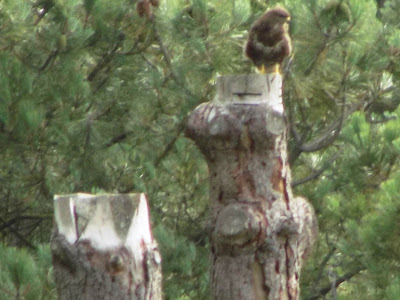This is a great white egret, specifically Walter White. This individual has been coming to Blashford every winter for fourteen years now. He was ringed as a chick in France and so we know he is fourteen years and three months old. This means he is by far the oldest known great white egret in the UK. When he first arrived he was one of only about three of the species to visit the UK. Now they are considerably more common and even breed here.
Walter's arrival is a sign that the new winter migrants are starting to arrive. On the River Avon I spotted this goosander happily feeding away.
Goosanders do breed in the UK but not here on the South coast- we only see migrants over the winter. I think this individual is probably a juvenile as it hasn't developed the sticky-up feathers on the back of the head.
Another juvenile bird I have seen recently is this tiny robin.
This was a very young bird- it still has very downy feathers and didn't try to flee when I came close. It did know to go into the undergrowth though but it wasn't very mobile. I suspect it had only left the nest that morning or the night before.
Here's a buzzard I saw recently:
Buzzards like to roost on dead trees and telephone poles as opposed to trees surrounded by leaves which obscure their view to the ground. Most buzzard prey is on the ground so they need a clear view to see movement in the grass. I think that the rangers at Avon Heath, where I saw this buzzard, have intentionally carved these trees so they make good buzzard perches.
When walking along a quiet footpath last week I came across a wasp nest that had been dug out of the ground.
The fact the nest was fairly intact and there were still a large number of wasps around suggests this was newly dug up, probably the night before I found it. I looked into what animal might be responsible for digging up this nest and it was almost certainly a badger. I was delighted to find this out as I've never had any evidence of badgers in the area before.
The reason badgers do this is to eat the wasp larvae. They dig through the top of the nest to get to the grubs and this avoids the worst of the stings from the guard wasps. It's also thought their thick fur helps to protect them from the stings too. Apparently badgers have been seen to ignore a wasps nest over several weeks and then go and dig it out on one particular night. It's thought that they do this to try to maximise the number and size of wasp grubs inside.
I was pleased this week to get another clear view of the roe deer doe and her two fawns.
It's only been two weeks since I last saw this family but the fawns have grown considerably in this time. They are now much closer in size to their mother and the white spots on them are gradually disappearing. They certainly appearing to be developing well which means they have a strong chance to making it through their first winter.
That's all for today but I'll be back with a post focusing on insects at the weekend. By the way, you can now follow this blog by e-mail. If you enter your e-mail address in the box at the side of the page (→→→ ) every new blog post will go straight into your inbox! See you soon.












No comments:
Post a Comment